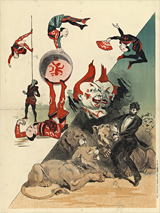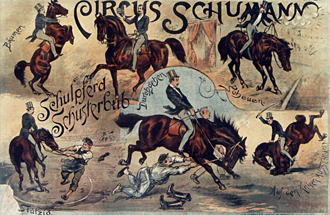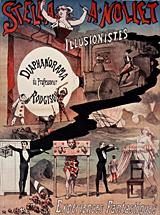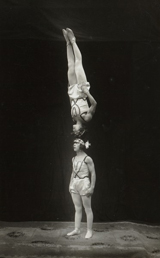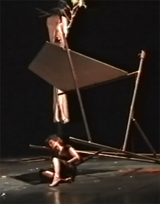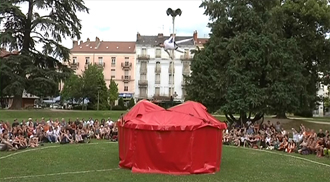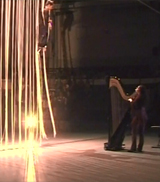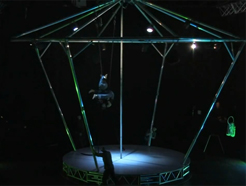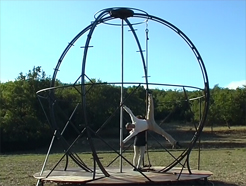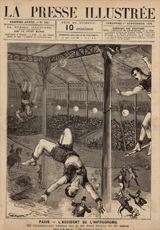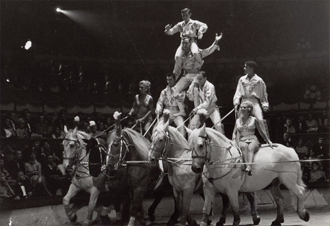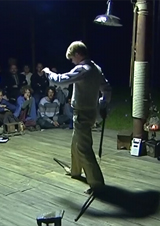by Philippe Goudard
Whether in a big top or a permanent circus, with travelling performers, subtle balancing acts, the trajectory of bodies or objects, animals, and applause for feats accomplished in the air above us, the circus space nourishes the special relation demonstrated by the art of the body, the frame, images and language.
Within this space, the acrobat creates a movement that he has intentionally structures and oriented in the area that contains us and surrounds everything. For artist and audience alike, the perception and evaluation of a distance between two points or two objects, an interval of time that a movement takes, enable them to feel proximity or distance, the duration, the process and the finality of an action and to forge a representation from it. Finally, places and mechanisms allocated to arts and circus practices determine their social or economic position.
Therefore the various circus arts and aesthetics enjoy corresponding different domains in which to solicit and guide our perceptions and our sensitive intuition of space and its corollary time: performance, the show forms and structure.
The performance space
In the realm of performance, the circus is a composite art that endlessly combines the disciplines of acrobatics, juggling, dressage and clowning, which are the fundamentals that go into the acts and programmes of traditional circus or contemporary circus shows. In each of these disciplines, the performer within each artist leaves a state of stability, whether static or dynamic, and voluntarily places himself in a situation of unbalance, which he then solves with an act or a position, before returning to the state of stability. Learning is based on these games of balance, with the aim of enabling the acquisition of basic acrobatic, juggling and dressage figures and positions (wheel, balance, somersault etc.), and actions (support, throws, suspensions, twists and propulsion).
From gravity-defying postural attitudes and the actions that they anticipate, invariant schemas are constructed, based on the sensory-motor performances of humans and animals in space. The sequences and variations of these figures and postures, which become bigger, faster and more frequent until they are mastered, are the result of an education in the circus arts. The visual, proprioceptive, cutaneous, aural and kinaesthetic receptors help the artist to pilot high-level physical and cognitive performances. Cognitive referents (standing, direction) as well as material ones, such as objects, apparatus or even partners (human and animal) make these performances perceptible.
These referents are also behavioural, for the clown's comic or transgressive act also adopts unbalanced behaviour, in a similar way as the abovementioned disciplines, but here it is in reference to normal social conventions rather that the laws of physics. Within the framework of the show, the vertical, the horizontal and gravity, are references for the trajectories of objects and bodies, forming, with the instigator of the actions, an autonomous system. According to the principle of enactment, this system is based on skills of self-organization and the physical integration of motor perceptions and abilities, in a self-situated and anticipative perspective. In this way, the circus artists' and the audience's minds continually integrate, by anticipation, the progression and the objectives of the action.
The talent and skill of circus artists resides in their capacity to create a situation of extreme unbalance, and then produce postures and figures through the cleverest, most complex and risky actions, that engage even their very existence. The aesthetic of the circus arts and professions resides therefore in modalities of expression and existence that see the artist expose himself to unbalance, instability and impermanence
The perception of and integration into the space are central to the circus performance.
Apparatus and accessories
The performance tools such as apparatus, accessories and animal required by each discipline form a second domain in which the circus dialogues with space. Instruments of the artists an markers of their performances, they enable the latter to take place in all circumstances, for they are independent of structures such as big tops, theatres, circuses and public spaces that host them. The physical qualities of the ground, the rigging of the trapeze, nets or tethers, the elasticity of balls, the weight of the animals, create close links between the circus and technology. Physics and communication technologies have been decisive in the development of circus forms. In the same way that music plays with sound, images and light, the circus works with ballistics. That is why, in dedicated circus spaces, body movement, apparatus and the moving of material create a primordial role for technology and logistics. Performances enhanced by the resistance, weight and elasticity of materials, by methods of transport and by the diffusion of light and sound, influence both the creation and the circulation of a work. Tomorrow, research applications into materials, magnetic fields, flux tubes, supra-conductors, robotics, LEDs, holographic projectors and 3D imagery, as well as nanotechnologies, sound diffusion and the wireless transmission of energy and quantities of information, will provide performers with new possibilities of creating and diffusing their works in space and time.
Although the circus space can always be reduced to the mechanisms needed for the artist's performance, another organisational scale of space places them within a broader project and gives them additional meaning by basing itself as much on the performance itself and the material used, as on the space given to the audience, for the field of application for these performances is that of the audience's reception of them.
That is why a third domain of relations between space and circus concerns architecture and stage design.
Architecture and stage design
In all its forms and means of expression, the circus present components shared by the "games and shows that use a central performance ground or circuit," according to the analysis by Gérard Lieber and Philippe Goudard: circus, bullfighting, games, stadium matches and competitions, combats and races or even theatrical improvisation matches or dice games etc. These games and show forms are universal and have shared components: the audience surrounds the action, the competitions are periodical or seasonal, the performances, competitions and feats are based on chance, luck, gravity, and surpassing physical or technical limitations. There is a voluntary exposition to risk, and lives are put at stake in a real or symbolic way.
For thousands of years, spaces have hosted the games and shows that today compose the circus arts, and they seem to have been created by architects with a triple project in mind: making them suitable for uniting communities of living beings, humans and animal; showing, through a monumental art form, their links and their position in the universe, and enabling rituals and games that demonstrate this to take place.
The archaic cursus, ancient stadiums, circuits, theatres, amphitheatres, arenas and Elizabethan theatres as well as modern or contemporary circuses respond to all or part of these requirements.
The genres of the current, traditional and contemporary circus and its forms – acts, programmes and pieces – are as varied as the spaces they occupy: stages, rings, public spaces etc. Today, a juggler, clown or acrobat can work interchangeably in a theatre, music hall, cinema, or on television, in a cabaret, public space or big top – or even – in a circus!
And at present, the performance place extends to an immaterial space, made of sound and image, travelling at the sound of light in the digital space.
An immaterial space
Interaction between the artist and spectator exists biologically. In the circus it determines a private, immaterial space of the mental structure composed of messages exchanged, of perceptions, sensations and representations of instability, impermanence and the risks linked to human existence. Spectators and artists are doted with the same cognitive abilities of movement and anticipation of action. The same neurones are activated both during the carrying out of an action and during its observation. The circus works on our representations of stability and instability, itinerancy and sedentariness, impermanence or perenniality, balance or imbalance. The circus artists invent techniques and apparatus, behaviours and ways of existing at the limits of balance and sometimes, of survival. This game of stability goes beyond the artistic field, extending to the logistic, economic, and social domains of the circus. Their ability to shake up and overthrow our references by exposing themselves to risk, and at the same time to overcome crisis, death or difference, touches us because we share the ability to perceive space.
We spontaneously form a circle around an event, and each person has their own place and point of view, in an equal and reciprocal way. But although the Latin circus "circle" and the Greek kirkos "ring," indicate the design of an enclosure, the words cricum "around" and kuklos "cycle" indicate that the circular design of the ring in itself does not suffice to define the circus. The notion of cycle adds the parameter of time to that of space, and reveals itself on several levels: the disappearance and resurgence of circus components throughout history, the movements of artists and the rhythm of shows (tours and seasons), the periodic use of a big top, a camp installation plan, the spatial and time composition of acts, the circularity of the delimited space of the circus ring, physical ballistics (human, animals and materials), training cycles (rehearsals) and the physiology of performances.
Archetypes
So it would appear that permanent and universal significance of today's circus components really exists. It comes from the combination of a particular organization of space and of the nature of actions carried out there. Even if you leave a dedicated space (an arena, circus, stadium, ring or circuit), to reduce the performance to only its physical actions, the risky games of imbalance that it implies are based on a real or symbolic manifestation of the risk of death or the renewal of life, of failure or of victory, of the permanent alternative that accompanies us always, from birth to death, of the desire to leave and that to return, between propulsion and fall.
By awakening our memory of the nomadic and sedentary, of standing up and of cycles of existence, the spaces of our "inner circus" seem dedicated to a tale of a single history, which dates back to the Neolithic revolution.



